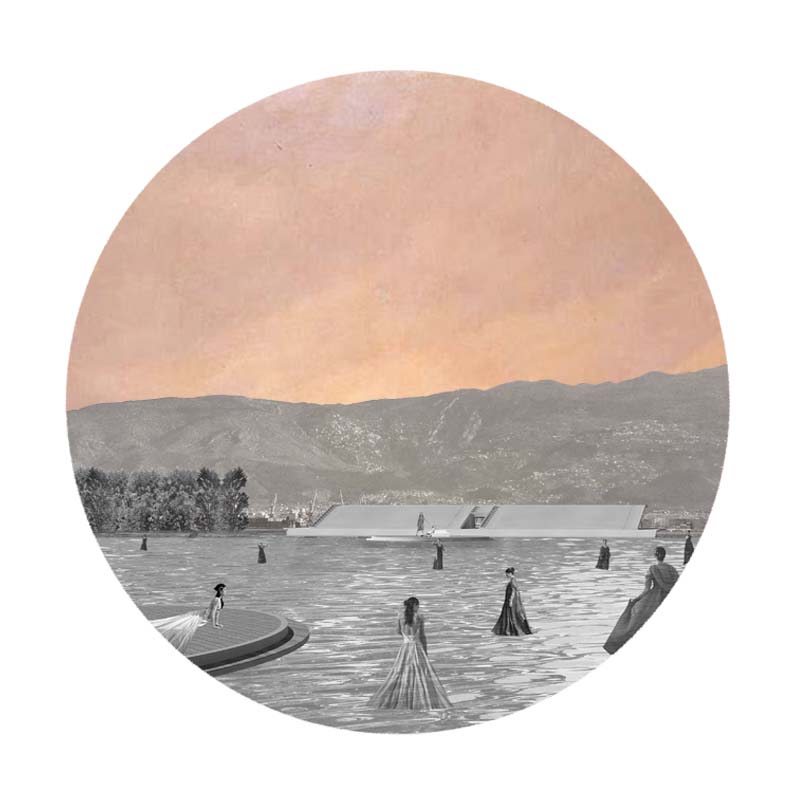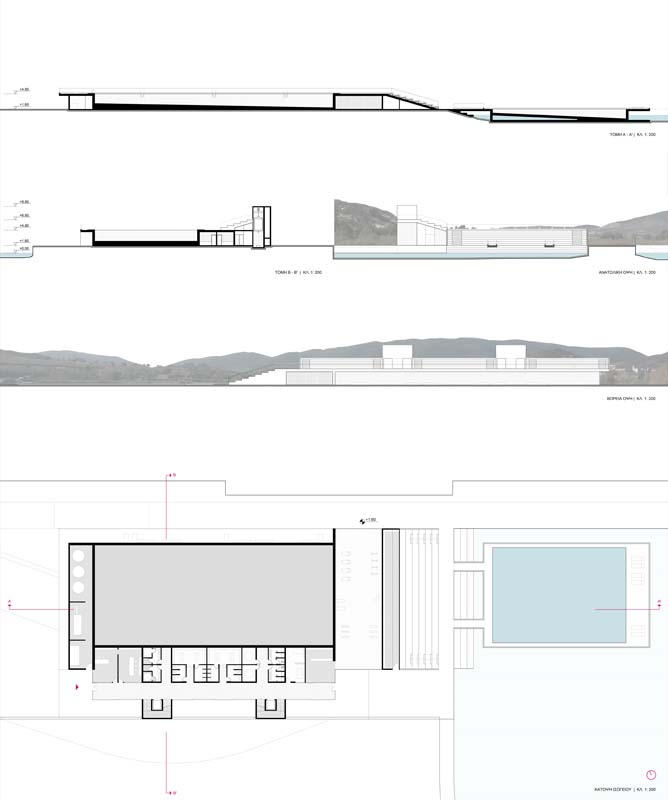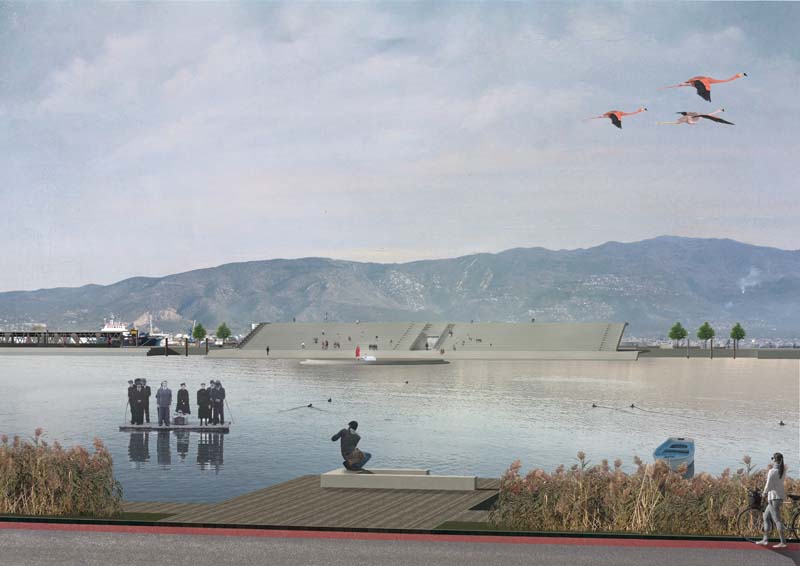

The concept concerns the construction of four independent bioclimatic houses in Vlasti, Kozani.
They are to be included in two adjacent plots of 93.05m2 and 200.6m2. These plots belong to four siblings and within them are stone-built buildings, which will be demolished.
Vlasti is at an altitude of 1.280m, has about 1.000 inhabitants and from the urban side is characterized as a "traditional interesting settlement", with the general and special building conditions applicable to this category.
When designing the dwellings, the basic parameters taken into account were the observance of the building conditions, the independence of the buildings and the bioclimatic requirements. Also, the size of each residence is about the same as the rest, so that it is distributed to the owners fairly, as far as possible.
As far as bioclimatic requirements are concerned, the proper orientation of the buildings, the contact between them, was initially chosen creating a "linearity" in the layout of the buildings, in order to limit the thermal losses. The conformation of the tumors also allows the natural lighting to enter the buildings and at the same time protects them from the extreme weather conditions prevailing in the winter.
The masonry in the main parts of the dwellings was also chosen to reduce the ecological footprint of the buildings, with the use of topical shale and reuse of 70% of the existing buildings.
Diversity to the facades of buildings, masonry, exposed concrete and smooth surfaces (coatings), creates an aesthetic result that is in harmony with neighboring buildings as well as with the entire settlement, because there are stone buildings and more recent buildings with surface coatings.
Supervisors: Tsangrassoulis Aris, Kanarelis Theoklis
Reference Number: 650












This study investigates the relation between the city and the theatre, as a mean of design, analysis and description of urban space. The field of the research is a part of the waterfront, in Volos, near the archaeological landscape of ancient Dimitriada. The design and analysis of the area is based on dramatic, architectural terms. Αsystem of amphitheathers is located in the bay and a floating, circular stage defines the background of the performance. The programmatic analysis focuses on the relation between the resident of the city and the sea and proposes the creation of public spaces and buildings which enhance its connection. Urban plantings serve as mean of revival of the archaeological space of Dimitriada. The city, as a dynamic system, reflects the sociopolitical changes and looks for different forms and mechanisms of expression. Contemporary dramaturgy has abolished the separation between performers’ space and urban space, transforming spectators and residents into social observers. The theatre uses different forms of expression and exploration of urban environments that evaluate the argument that cities are “live performances” and the landscape becomes the “protagonist” of a public, urban drama.
Supervisor: Papadopoulos Spiros
Reference Number: 627


Nowadays, due to the progressive deindustrialization of their certain departments, lot of ports are transforming into cultural centers, international poles of attraction that has a lot to offer. Due to this dynamic interference, a lot of silos simply have been maintained as historical monuments while in other occasions have transformed into center of residence and tourism or culture center. The following thesis is about the redevelopment of a certain department of the commercial port of Volos, the creation of student installations, and the re-use of silo and some traditional buildings around it. Taking into consideration the needs of the surrounding area, the goal was to make these facilities part of the city. The choice of putting the student facilities in this particular part of the city, was made after taking into consideration the important places found in near distance, the academic installations, university buildings and the library, the public transportation but also the commercial center of the city. Due to the general redeployment of the jetty, architecture plays an important role. A new, modern building that includes 200 dorms and lot of other facilities is designed. The placement of the new building was made after taking into consideration, the view from the rooms that connect with the city and the tourist port. A great role played the fact that the new building should not compete the building of silo, which is considered a landmark for the city of Volos. As a result, a solution had to be found in order these two buildings to coexist harmoniously. The re-use of the silo is made, respecting the building’s industrial character. Externally, its’ big blind aspectswere maintained in general except some slices that were made in order to put some natural light inside the building. As far as the interior is concerned, the main target was to put some places inside in use, so some part of the beehives in the buildings’ center had to be detached.
Supervisor: Manolidis Kostas
Reference Number: 642


This project is about a children summer camping and has a capacity f 120 children and children with movement difficulties.The intervention area is located on the beach of Variko, Litochoro, in the prefecture of Pieria. The coast of this prefecture and especially the area zone between Litochoro and Katerini, is an area of exceptional natural beauty, as it is located near Mount Olympus without the absence of water.
The first element that was taken into consideration during the design process was the attempt all the buildings to take advantage of the mountain and the sea view at the same time, as far as possible. This resulted in the first designed lines, parallel to the axis of the mountain and the sea, creating a dynamic motion that intersects perpendicularly the plot and linking two points of interest of the camping. One more element that was taken into account was the creation of a secondary strong motion right next to the vertical one which crosses the other necessary operations of the project and ends with the shape of a marine jetty in the sea.
More specifically, the project includes, children guest dormitories separated to boys and girls where between of them exists the relaxation area that includes a swimming pool and a playground. Subsequently, near to children houses there is the gathering area for team facilities. Above there is the sports zone with pitches, small kiosks and a movement’s restoration building. In the center of the plot there is the roofed feeding area. Furthermore, there is a parking and continuing to the other side of the site we can find the employees dormitories as well as the stables with the circular ride (rodeo). To conclude, along the entire length of the vertical road we can find small kiosks with the administration offices for the absolute control and information of children at all times.
Supervisor: Triantafillidis Giorgos
Reference Number: 633

